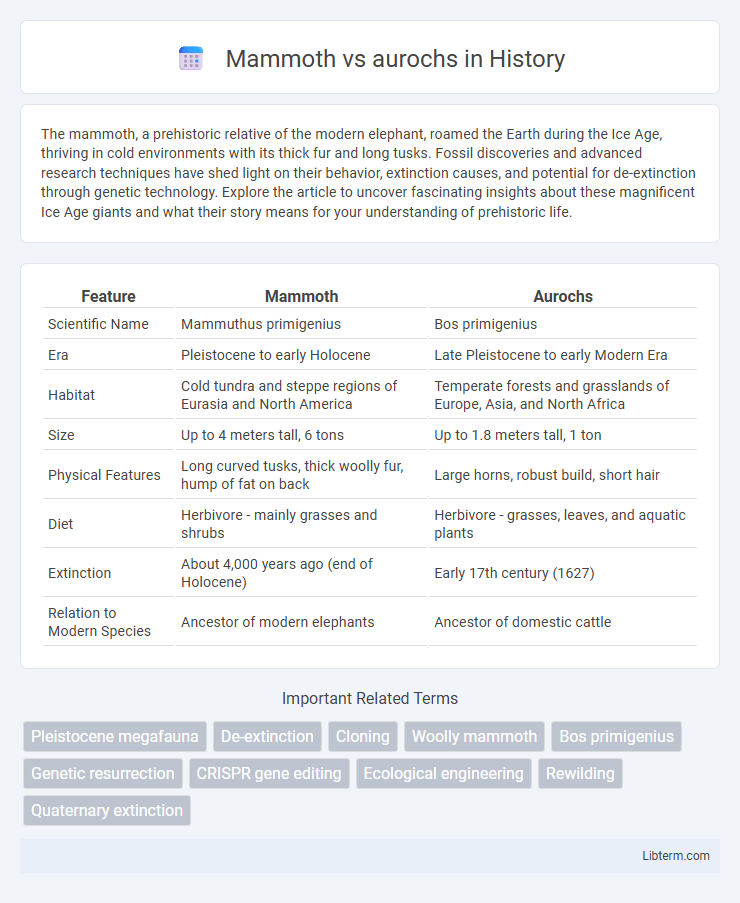The mammoth, a prehistoric relative of the modern elephant, roamed the Earth during the Ice Age, thriving in cold environments with its thick fur and long tusks. Fossil discoveries and advanced research techniques have shed light on their behavior, extinction causes, and potential for de-extinction through genetic technology. Explore the article to uncover fascinating insights about these magnificent Ice Age giants and what their story means for your understanding of prehistoric life.
Table of Comparison
| Feature | Mammoth | Aurochs |
|---|---|---|
| Scientific Name | Mammuthus primigenius | Bos primigenius |
| Era | Pleistocene to early Holocene | Late Pleistocene to early Modern Era |
| Habitat | Cold tundra and steppe regions of Eurasia and North America | Temperate forests and grasslands of Europe, Asia, and North Africa |
| Size | Up to 4 meters tall, 6 tons | Up to 1.8 meters tall, 1 ton |
| Physical Features | Long curved tusks, thick woolly fur, hump of fat on back | Large horns, robust build, short hair |
| Diet | Herbivore - mainly grasses and shrubs | Herbivore - grasses, leaves, and aquatic plants |
| Extinction | About 4,000 years ago (end of Holocene) | Early 17th century (1627) |
| Relation to Modern Species | Ancestor of modern elephants | Ancestor of domestic cattle |
Introduction to Mammoths and Aurochs
Mammoths were prehistoric elephant-like mammals known for their massive size and long, curved tusks, thriving during the Pleistocene epoch before becoming extinct around 4,000 years ago. Aurochs were large wild ancestors of domestic cattle, characterized by their robust build and prominent horns, roaming Europe, Asia, and North Africa until their extinction in the 17th century. Both species played significant roles in their ecosystems, with mammoths influencing tundra vegetation and aurochs contributing to grassland ecology.
Evolutionary Origins and Ancestry
Mammoths and aurochs evolved from distinct lineages within the order Proboscidea and the family Bovidae, respectively. Mammoths, part of the Elephantidae family, trace their ancestry to early proboscideans that emerged approximately 60 million years ago, adapting to Ice Age environments. Aurochs, the wild ancestors of domestic cattle, evolved from early bovids in the late Pliocene around 2 million years ago, playing a crucial role in Eurasian megafauna ecosystems.
Physical Characteristics: Size and Appearance
Mammoths were massive prehistoric elephants characterized by long, curved tusks and thick, shaggy fur adapted to cold climates, typically standing up to 13 feet tall at the shoulder and weighing around 6 to 8 tons. Aurochs, ancestors of modern cattle, were large wild bovines with robust bodies, long legs, and distinctively curved horns, standing about 5.6 feet tall at the shoulder and weighing up to 1,500 kilograms. The stark size difference and differing adaptations highlight mammoths' cold-environment specialization versus aurochs' adaptation to temperate forests and grasslands.
Habitat and Geographic Distribution
Mammoths primarily inhabited the cold, tundra and steppe environments of the Northern Hemisphere, ranging across North America, Europe, and Asia during the Pleistocene epoch. Aurochs thrived in diverse habitats including open woodlands, grasslands, and wetlands across Europe, Asia, and North Africa. The geographic distribution of mammoths contracted with the end of the Ice Age, whereas aurochs persisted in temperate regions until their extinction in the 17th century.
Dietary Habits and Feeding Behaviors
Mammoths primarily fed on grasses, sedges, and shrubs, using their large molars to grind tough vegetation found in cold, steppe environments. Aurochs, ancestors of modern cattle, grazed on a diverse diet of grasses and leafy plants in temperate forests and grasslands, exhibiting selective feeding behaviors to optimize nutrient intake. These dietary adaptations reflect their ecological niches, with mammoths adapting to Pleistocene tundra diets while aurochs thrived in varied habitats with richer vegetation.
Social Structure and Behavior Patterns
Mammoths exhibited strong herd social structures, often led by matriarchal females, with complex behaviors centered on cooperation and protection within family groups. Aurochs, ancestors of modern cattle, also lived in social herds dominated by dominant bulls during the breeding season, but their group dynamics were primarily driven by grazing patterns and territorial defense. While mammoths relied on coordinated movement for survival in harsh Ice Age environments, aurochs displayed more aggressive and territorial behaviors linked to resource competition.
Role in Ancient Ecosystems
Mammoths, as large herbivores of the Ice Age, played a crucial role in shaping Pleistocene ecosystems by influencing vegetation patterns and nutrient cycling through their grazing and trampling behaviors. Aurochs, the wild ancestors of domestic cattle, impacted ancient European and Asian landscapes by maintaining open grasslands, which supported diverse plant and animal communities through their browsing and grazing activities. Both species contributed to ecosystem dynamics by creating habitats that sustained biodiversity and helped regulate ecological balance in prehistoric environments.
Interactions with Early Humans
Mammoths and aurochs were crucial to early human survival, as humans hunted both for food, tools, and clothing. Evidence from cave paintings and archaeological sites indicates cooperative hunting strategies and tool use to capture these large animals. The extinction of mammoths and the decline of aurochs populations profoundly impacted early human diets and migration patterns.
Extinction Events and Causes
Mammoths became extinct approximately 4,000 years ago, primarily due to climate change during the end of the Pleistocene epoch combined with human hunting pressures. Aurochs disappeared by the early 17th century, largely because of habitat loss and intensive hunting throughout Europe. Both species' extinction events highlight the impact of environmental shifts and anthropogenic activities on megafaunal survival.
Legacy and De-extinction Efforts
Mammoths and aurochs hold significant legacy as iconic species that once shaped ecosystems and human history, with mammoths representing Ice Age megafauna and aurochs as wild ancestors of modern cattle. De-extinction efforts primarily focus on mammoths, utilizing advanced genetic engineering and cloning techniques to potentially reintroduce them into Arctic environments to combat climate change. Aurochs de-extinction projects rely on selective breeding programs to revive traits in domestic cattle, emphasizing agricultural and ecological restoration.
Mammoth Infographic

 libterm.com
libterm.com